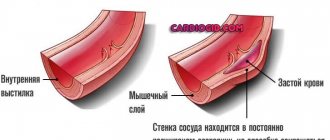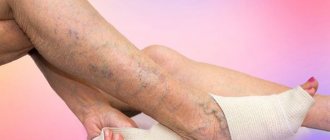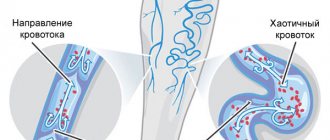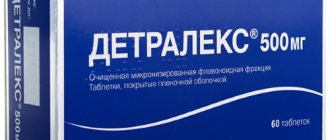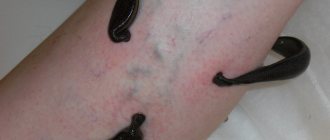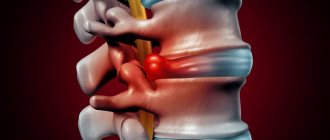Types of trophic ulcers on the legs
Trophic ulcers on the legs (the photo will give you a general idea of the disease) experts divide into several types, taking into account the cause of their occurrence. The general classification involves dividing ulcers into venous and arterial. About 80% of patients suffer from the first type of disorder.
Arterial ulcers develop as a result of impaired arterial circulation. Externally they look like rounded shallow cavities filled with pus and are localized in the foot area. Most often diagnosed in elderly patients suffering from atherosclerosis or coronary heart disease.
Venous ulcers develop slowly and are the result of impaired venous circulation. They look like dark purple spots that gradually grow. Occurs in young and elderly patients.
Taking into account the cause of the disease, the following types of necrotic changes are distinguished:
- Diabetic ulcers affect patients suffering from type 1 diabetes mellitus. Patients with type 2 disease are less likely to suffer from such disorders. A characteristic sign of a diabetic ulcer is the localization of the lesion in the area of the big toe.
- Neurotrophic ulcers can be localized in the thighs, legs, and feet. They develop when tissue innervation is disrupted and affect superficial and deep tissues.
- Hypertensive ulcers more often affect patients with uncontrolled arterial hypertension, when not only blood circulation is impaired, but also small arteries are destroyed. Externally they appear as burgundy or bluish-red spots, painful to the touch.
- Pyogenic species more often affect patients who violate basic rules of personal hygiene on an ongoing basis (for example, people who do not have a specific place of residence). The affected area is often the lower extremities; the ulcers are usually not deep, but can affect the muscles with a long course of the disease.
Each type has its own characteristics and symptoms. A particular type of disorder can be diagnosed after collecting an anamnesis and examination.
Medications
In the initial stages, conservative therapy is prescribed using the following medications:
- Angioprotectors
. Tablets (Detralex) and ointments such as Lyoton or Troxevasin significantly reduce vascular permeability and improve impaired microcirculation. - Antibacterial preparations containing antibiotic and antiseptic
. These include Levomycetin, Miramistin. If the ulcer becomes infected, then injections of ampicillin or cephalosporin antibiotics are performed. - Antihistamine tablets to relieve itching
. Suprastin, Fenistil. - Antiplatelet agents
. Aspirin inhibits the blockage of the wound by platelets so that they cannot attach to the vessel. Ventavis or Trental are used for injections. - Antispasmodics
. No-shpa, Papazol. - Medicines that speed up wound healing
. Solcoseryl, Ebermin. - Anti-inflammatory tablets
Ibuprofen, Ketorolac or ointments Diclofenac, Levomekol.
Before applying the external agent, it is necessary to wash the wound with hydrogen peroxide, chlorhesidine or saline solution and remove the pus. It is recommended to use special Activtex or Proteox wipes.
Wipes for wound healing
Activtex wipes with special impregnation are used for dressing wounds, abrasions and after burns. They contain antimicrobial and anti-inflammatory substances that have an analgesic effect, prevent suppuration and infection.
The wipes contain chlorhexidine, lidocaine and furagin, which have an antiseptic and analgesic effect. Vitamins, eucalyptus and sea buckthorn oil also contribute to the healing of ulcers.
Upon contact with water, a gel begins to form, which is absorbed into the sore spot and heals it.
The napkin should always be damp. With rapid absorption, it is permissible to additionally wet the material 2-3 times a day.
Proteox wipes have a valuable composition; they quickly clear the ulcer of scab and necrosis, stimulating healing. Suitable for the treatment of trophic, venous and diabetic ulcers, abscesses, bedsores, burns. Trypsin dissolves necrosis, pus, blood clots and activates epithelial growth. Mexidol is an analogue of vitamin B and a powerful antioxidant that accelerates the process of regeneration and recovery.
ASD
An effective antiseptic Dorogov stimulant is widely used to treat many diseases, including dermatological ones. For patients with trophic ulcers, the ASD-3 fraction is recommended in the form of ointments and compresses.
To prepare the solution, you need to mix 1 tsp. fractions with 20 tsp. vegetable oil. Soak a linen napkin in the solution and apply to the wound. Place cling film or parchment on top of the compress, then cotton wool and secure with a bandage. Carry out the procedure once a day. You can prepare an ointment using half a spoon of ASD and 50 grams of melted pork fat. Treat the wound with this mixture 2-3 times a day.
ASD-3 cannot be used internally; there is a fraction of ASD-2 for this. 0.5 ml of the drug should be mixed with 0.5 cups of cooled boiled water. For 5 days you should take the medicine before meals once a day. Then break for 3 days and repeat for up to 2 months. During this period, you should consume more water and sour fruits.
Wound healing and immunomodulatory drug:
- helps fight infection and inflammation;
- destroys pathogenic microflora;
- heals tissue;
- improves trophism;
- increases protective properties;
- improves the condition.
The medicine helps cure trophic ulcers. The patient is only required to follow the recommendations for taking the unique product and not scratch the wound.
Stages and degrees of trophic ulcers on the legs
Trophic ulcers on the legs (photos by stages help a person to independently assess his condition) in most cases develop gradually. Regardless of the type of disease, the necrotic process develops in several stages.
At the initial stage, the patient feels only mild discomfort. The skin becomes cold (with an arterial ulcer) or hot (with a venous ulcer) to the touch. In the area of future localization of the ulcer, the skin thickens. The patient may report itching in the affected area, which intensifies upon contact with chemicals. In addition, the skin may be excessively dry and areas of peeling may appear.
As the disease progresses, minor external manifestations appear in problem areas.
Exudation is the next stage of ulcer development. An edematous area appears, in the center of which there is a necrotic focus, gradually spreading to the entire area. The entire exudation process lasts approximately 14 days, sometimes longer.
The next stage is called repair or granulation and lasts 3-4 weeks. The ulcer area becomes covered with fresh granulations that look like small red dots. The depth of the lesion increases, but at the same time, cleansing of necrotic masses and pus occurs.
Epithelization is the next stage, which can last several months depending on the age of the patient and the individual characteristics of the body. In this case, the ulcer heals, tissue is restored and the size of the affected area decreases.
It is worth remembering that with any type of disease it occurs in several stages, but at one of them an infection may occur, which disrupts the natural course of the process and prolongs each period.
What it is?
A trophic ulcer on the leg is a deep lesion of the skin that does not heal for a long time or regularly recurs. Skin lesions on the lower extremities are classified as ulcers if their duration exceeds 6 weeks and does not show a spontaneous tendency to heal.
The mechanism of formation of the pathology has not been fully studied; many conditions and diseases have been identified and described, the complication of which may be its appearance. Modern doctors consider the main causes of the condition to be:
- disturbances in the passage of blood through the veins and arteries;
- endocrinological and hormonal disorders;
- insufficient blood circulation in the affected area;
- oxygen starvation and nutritional deficiency of tissue cells;
- pathology of lymphatic drainage;
- extensive, systemic damage to the body by infection.
- heredity.
Most often, the occurrence of wounds is recorded in elderly people after 65 years of age (with some forms of pathology, women are affected after 45 years of age) against the background of:
- forced immobility;
- injuries received;
- deep general exhaustion of the body.
Depending on the type of underlying disease, ulcers form on the lower extremities:
- appeared against the background of hypertension (Martorell's ulcer);
- combined type, the cause of which was several factors that have a similar effect.
- resulting from lesions by malignant tumors;
- caused by a violation of venous or arterial circulation - venous or arterial;
- provoked by the development of diabetes mellitus (diabetic foot or neurotrophic);
- formed after limb injuries;
- infectious (pyogenic), arising against the background of existing skin lesions;
- caused by other reasons.
The most common are varicose and neurotrophic (diabetic) trophic ulcers, you can see photos here, arterial and mixed.
What a trophic ulcer looks like depends on the type of lesion:
- ulcers that arise against the background of increased pressure are deep with clear edges, tendons are visible at the bottom, under the scab crust;
- venous ones are distinguished by their round shape, uneven edges and purulent filling;
- diabetic deep and dry, with rough keratinized edges, located on the feet;
- infectious multiple, small in diameter, located throughout the lower leg.
Symptoms of trophic ulcers on the legs
Each patient experiences the disease differently. Symptoms largely depend on the stage of development and concomitant diseases. In most cases, patients report swelling of the limb, heaviness and fatigue when performing physical work.
In the evening, one or both legs increase in volume, especially in the lower leg area. The skin becomes shiny, and upon close examination, fine cracks can be seen.
After some time, the patient notices burgundy, purple or red spots localized in the lower leg or foot area. When touched, moderate or severe pain is felt. After this, a necrotic area appears in the middle of the spot, from which serous fluid or pus is released. The pain intensifies, the person tries to avoid exertion.
Trophic ulcers on the legs. Photo
Further, constant pain joins the symptoms, the limb becomes hot to the touch, signs of general inflammation appear in the form of increased body temperature, weakness, headache, and loss of appetite.
At an advanced stage and when infection is attached, the edges of the ulcer become black, the depth of the lesion increases, and the patient’s general condition worsens. Pain in the limb forces a person to take large doses of drugs, which also negatively affects his well-being, but slightly weakens the symptoms.
Stages of ulcer development
In medicine, there are 4 stages of development of a trophic ulcer and each of them has distinctive features:
- The initial stage is characterized by superficial skin lesions and the appearance of reddish, whitish or bluish spots on the leg. Swelling is observed in these places and the skin acquires a glossy shine. Sometimes the patient experiences convulsions, chills and slight weakness. Small ulcers form on the skin. The first stage lasts from 1 day to 1.5 months.
- The second is characterized by the rejection of dead tissue, the ulcers acquire clear outlines, and pus, mucus or bloody discharge oozes from them. Itching and unpleasant odor appear. The patient feels weak and his body temperature rises. The second phase lasts up to one and a half months.
- Third , the structure of soft tissues is disrupted, deep wounds occur (down to the bone). At this stage, as a rule, surgical intervention is not possible.
- Fourth - at this stage the healing process begins, the size of the wounds decreases, and tissue healing occurs. This phase can drag on for a long time.
But regardless of the stage of the disease, wounds require daily care and treatment.
Causes of trophic ulcers on the legs
Trophic ulcers on the legs (photos of external manifestations can be seen in a specialist’s office) arise as a result of many factors.
Specific types of disease are provoked by certain reasons: diabetic - advanced diabetes mellitus, hypertensive - severe arterial hypertension, neurotrophic - diseases of the brain and spinal cord, accompanied by impaired tissue innervation.
A pyogenic ulcer is the result of constantly wearing dirty clothes, poor personal hygiene, and frequent hypothermia.
However, there are common reasons that can provoke the formation of an area of necrosis:
- Regular wearing of uncomfortable, narrow shoes, which causes poor circulation and tissue nutrition.
- Varicose veins, which affects many young and middle-aged women.
- Thrombophlebitis, causing stagnation of blood in the extremities, disruption of tissue nutrition.
- Professional activities associated with the patient constantly remaining in an upright position for a long time (salespeople, surgeons, teachers). In this case, the blood in the veins of the legs stagnates, which leads to the appearance of ulcers.
- Regular hypothermia of the body or specifically the lower extremities.
- Long-term smoking, which certainly leads to damage to the arteries of the legs.
- Obliterating endarteritis is a serious disease accompanied by damage to the arteries and gradual necrosis of not only the skin, but also deep tissues.
- Diseases that cause fragility of the vascular wall.
- Skin exposure to chemicals.
- Frostbite of the lower extremities or burns of varying severity.
- Deficiency of vitamins and minerals as a result of poor nutrition.
- Excessive body weight, which increases the load on the vessels of the lower extremities.
One or more predisposing factors provoke tissue malnutrition and the development of a trophic ulcer.
Prevention of disease development
As with most chronic diseases, prevention of trophic ulcers in varicose veins is extremely important. First of all, constant monitoring by the patient of the condition of the veins and arteries of the legs is necessary. To do this, this category of patients must undergo preventive treatment for varicose veins once every six months.
The rest of the time you need to change your lifestyle. Avoid excessive stress on the provoked limbs as much as possible; physical impacts on the legs and feet are contraindicated.
It is necessary to constantly pay attention to exercise therapy. Doctors may recommend special sets of exercises to strengthen the walls of blood vessels in the legs. In everyday life, it is recommended to use special compression garments or elastic bandages to prevent congestion in the veins of the lower extremities. Mud baths and balneological resorts have already been discussed above.
The main condition for preventing the occurrence of ulcers in varicose veins is careful adherence to all recommendations of the attending physician. In this case, such a formidable complication as trophic ulcers will not join varicose veins.
Diagnosis of trophic ulcers on the legs
To examine the patient, methods standard for all diseases are used, as well as those specifically aimed at studying the vessels of the lower extremities.
| Method name | Description | Venue, cost |
| General examination and questioning of the patient | The doctor interviews the patient, identifies the probable cause of the disorder, examines the affected area, measures body temperature and blood pressure | It is carried out in any medical institution, usually does not require material costs |
| Clinical and biochemical blood test | The first type of diagnosis helps determine the general condition of the patient. The second reveals a tendency to thrombus formation, which is important at this stage | It is carried out on an outpatient basis in public and private clinics. In the first case, payment is usually not required. In private institutions the price ranges from 300-500 rubles. |
| Bacteriological examination of a sample from an ulcer | A sample of pus, affected tissue, or exudate is taken from the ulcer to determine the presence of pathogens or infection | It is carried out in any institution, the price is 200-600 rubles. depending on the status of the clinic and equipment |
| Dopplerography | One of the most effective non-invasive diagnostic methods involves the use of an ultrasound machine to study the condition of the blood vessels of the legs | It is not carried out in every hospital, only where the equipment is available. The price is 500-1000 rubles. |
| Angiography | The most effective and frequently used examination method involves the injection of a contrast agent into the affected vessels, followed by examination using X-rays. A series of images allows the doctor to understand which vessels are affected | The procedure is carried out only in specialized clinics, the price ranges from 600-1200 rubles. |
| MRI | It is not always used, only if other methods are ineffective. Involves a complete examination of the extremities using a magnetic field and contrast agent for better visualization of the affected area. Helps identify the area where circulatory problems have occurred | This is not always carried out, the equipment is usually available in private clinics, the price is approximately 1300-2000 rubles. |
| ECG | Helps the doctor assess the functioning of the heart. Used almost always, especially for patients suffering from any diseases of the cardiovascular system | Equipment is available from government agencies, usually no payment is required |
The most effective method is angiography, as well as Dopplerography. These methods help to see the exact location of the vessels that have been affected. However, only a comprehensive examination will allow us to establish the cause of the violation.
When to see a doctor
Trophic ulcers require proper and timely treatment. On the legs, the disease progresses quite quickly. If you evaluate photos of patients every 3-4 weeks, you will understand that you should not hesitate to visit a doctor.
Experts recommend contacting a medical facility immediately after the first symptoms, swelling and itching appear. If, after the examination, areas of circulatory disorders, blood clots, and damaged vessels are identified, it is important to immediately visit a doctor. Only treatment at the initial stage guarantees recovery.
Treatment of trophic ulcers is usually carried out by a phlebologist or vascular surgeon. But in small towns such specialized specialists are not always available. If they are absent, the patient should consult a regular surgeon.
Ulcers on the legs due to varicose veins: surgical treatment or what to do when ointments do not help?
Surgical method for treating trophic ulcers
What to do if varicose ulcers do not go away? When step-by-step conservative treatment of a trophic ulcer of the leg with varicose veins does not give a positive effect, then it is necessary to use surgical treatment methods. The decision is made quickly, because long-term non-healing varicose ulcers lead to complications of various types, causing emergency hospitalization of the patient. Such complications will be: tetanus (Tetanus), bleeding, wound myiasis (Myiasis), thrombophlebitis, periostitis (Periostitis), tendonitis (Tendinitis), etc. To stop the progression of tissue destruction and prevent the development of complications, the doctor offers the following ways to quickly solve problems:
- Laser coagulation of veins.
Allows you to eliminate the cause of ulceration – varicose veins – in a minimally invasive way using the thermal energy of laser radiation;
- Sclerotherapy.
Using a special sclerosing drug, the walls of the affected vein are “glued together”, and the vessel itself is excluded from the bloodstream;
- Crossectomy.
Ligation and intersection of the great saphenous vein and the vessels flowing into it on the lower limb.
During the rehabilitation period after surgery, the patient notes an improvement in his condition, and the trophic ulcer begins to heal thanks to the use of conservative treatment methods. In certain cases, in order to completely eliminate trophic ulcers in varicose veins, specialists use traditional methods of skin plastic surgery.
Prevention of trophic ulcers on the legs
Preventing a disease is always easier than treating it. To prevent the appearance of trophic ulcers, it is recommended to pay attention to your diet, including fresh vegetables, fruits, juices, dairy products, herbs, and nuts.
It is recommended to give up cigarettes and reduce the amount of alcohol consumed to a minimum. In addition, you should avoid hypothermia of the extremities, wear comfortable, spacious shoes, and do not overwork. If your professional activity requires frequent standing in an upright position for a long time, you need to warm up regularly, not allowing the blood to stagnate.
If signs of any vascular or heart disease appear, it is recommended not to violate the doctor’s recommendations so as not to aggravate the condition. If the patient notices symptoms indicating the formation of an ulcer, you should immediately contact a specialist.
Frequently asked questions from our patients on the Internet about trophic ulcers
How to treat non-healing wounds on the legs? Victoria from Ufa asks:
Dear Victoria! To effectively treat non-healing leg wounds, it is necessary to understand how such wounds appeared. Long-term non-healing wounds on the legs can form as a result of a number of completely different pathologies, and each requires its own specific treatment.
How to treat non-healing wounds at home? Maria from Vologda asks:
Dear Maria! Before you begin to treat long-term non-healing wounds at home, you need to find out the cause of such wounds. Most often this is:
- Diabetes.
- Obliterating atherosclerosis.
- Chronic venous insufficiency.
If you want to cure long-term non-healing wounds, then in addition to the local use of ointments, it is necessary to deal with the underlying pathology that caused the problem.
How to treat a deep wound? Asks Nadezhda from Krasnogorsk:
Dear Nadezhda! Question: how to treat a deep wound should be asked to the doctor during an in-person consultation. Treating such wounds on your own, using the Internet, can be fraught with progression of the process and the development of a life-threatening condition.
My father developed sores on his legs six months ago, how can I get rid of them? Vera from Kemerovo asks:
Dear Vera! If “sores” on your legs appear and do not go away for a long time, as a rule, only a doctor will help you get rid of them. Long-term non-healing wounds are often a sign of a serious pathology that requires specific treatment.
Treatment methods for trophic ulcers on the legs
To eliminate lesions and prevent complications, specialists prescribe medications. Additionally, many patients use traditional medicine recipes and other methods.
Medications
In most cases, external agents are used as the main treatment. However, to enhance the effect, the specialist additionally prescribes systemic drugs.
The most popular will be the following:
- Solcoseryl is an effective ointment that contains an extract from the blood of young calves. It has an anti-inflammatory, regenerating effect, accelerates the tissue healing process, and prevents complications. Used to treat wounds 1 to 3 times a day. Apply the composition in a thin layer, do not rub in. Course duration is from 2 to 4 weeks. The price of the product starts from 300 rubles. per package.
- Stellanin is an effective ointment with regenerating, antibacterial, anti-inflammatory properties. The active component is diethylbenzimidazolium triiodide, which effectively fights various microorganisms and at the same time stimulates tissue repair. The ointment must be used for 2-3 weeks, applied in a thin layer no more than 3 times a day. The medicine should not be rubbed in. The price of the product is approximately 400 rubles.
- Argosulfan is a popular cream that contains silver sulfathizole. It has unique antimicrobial, anti-inflammatory and regenerating properties. The duration of treatment is from 2 to 4 weeks. The cream must be used externally, applied in a thin layer 2 times a day. The medicine is considered very effective. The price of the medicine is on average 350-450 rubles. per tube 40 g.
- Latren is a medication for systemic use in the form of a solution for intravenous drip administration. Dilates blood vessels, normalizes local and general blood circulation, eliminates swelling of the extremities. Prescribed in courses of 5-10 days with daily administration of 200 ml of solution. The price of 1 bottle starts from 120 rubles.
- Rheosorbilact is an effective medication prescribed for blood purification. It is used in cases of advanced trophic ulcers with infection entering the blood. The patient is administered from 200 to 400 ml of the drug per day using a dropper. Course duration is from 3 to 10 days. The price of 1 bottle of 200 m is approximately 100 rubles.
Complex treatment of trophic ulcers allows you to speed up recovery and prevent complications. In some cases, specialists prescribe systemic antibiotics, such as ceftriaxone, to reduce the risk of blood poisoning.
Such products are considered very effective when used correctly.
Traditional methods
Trophic ulcers on the legs (the specialist often shows the photo to the patient) are treated by many patients using alternative medicine recipes.
Some of them are quite effective.
Dry tartar leaves are used quite often for treatment. It is necessary to take the raw materials and grind them into powder. After washing the ulcers with hydrogen peroxide, sprinkle them with powder, apply a clean bandage or gauze on top, and leave overnight. Repeat daily for 2 weeks. The recipe helps speed up healing and cleanse the wound of pus, and is considered very effective.
Garlic broth is used for compresses. You can prepare it from 5 cloves of garlic and 1 liter of water. Cook the garlic for at least 10 minutes, filter. Moisten a piece of gauze or cloth in the hot mixture, apply to the affected areas, cover with cling film, and leave for 2 hours. Repeat daily for 1-2 weeks.
Mixture of 1 tbsp. l. honey and the white of 1 fresh chicken egg - an effective and safe remedy. It is necessary to apply it to the affected areas, apply a burdock leaf on top and wrap the leg in cellophane, leaving it overnight. The course of treatment consists of 5-8 daily sessions.
Any of the remedies is effective and helps speed up recovery. However, they can only be used after consulting a doctor. In some cases, such treatment may harm the patient.
Other methods
Vacuum therapy is one of the types of surgical intervention in which pus and necrotic masses are removed from the wound in one procedure, it is cleaned and treated with antiseptic solutions, which speeds up recovery and eliminates the possibility of infection entering the blood. One session is enough and the patient feels relief. The method is considered effective.
Medicinal electrophoresis is a type of physiotherapy in which special pads impregnated with antibacterial agents are attached to the wound.
Using high-frequency electric current, drug components are delivered to the deep layers, which speeds up recovery and prevents the spread of necrosis. To achieve results, you will need at least 10 sessions every 2-3 days.
Such methods are used frequently, are highly effective and speed up recovery.
Is it possible to treat trophic ulcers at home?
Damage to the skin or mucous membranes, during development, penetrating deep into the subcutaneous layers and muscles, lasting more than 6 weeks without a tendency to heal, is designated as a trophic ulcer. It arises as a complication and is evidence of the depth and, in many cases, neglect of the patient’s underlying illness.
If you imagine a pyramid, at the top of which there is a trophic ulcer with its deep damage to the limb, then below will be the main disease that triggered its appearance, and at the very bottom there will be a large set of various congenital and acquired diseases that have caused and maintain disorders in tissues, blood vessels, blood and cells that do not allow the body to independently cope with the wound and the infection located in it.
It is pointless to treat a trophic ulcer in isolation from the disease that caused it, and since it is caused by severe, sometimes incurable diseases, the patient needs to be patient and courageous.
Therapy for such lesions is long-term and the patient is better treated on an outpatient basis. Treatment of trophic ulcers of the lower extremities at home will include:
- treatment of the underlying disease according to medical prescriptions;
- daily dressing of trophic ulcers;
- wound care;
- use of drugs for treatment;
- monitoring the occurrence of new lesions;
- preventive measures to prevent the appearance of ulcers.
Unfortunately, for many patients, constantly visiting a doctor and buying medications with a tiny pension is an expensive pleasure, so they consider home treatment and traditional medicine the most acceptable for themselves. With the correct implementation of the received prescriptions, proper bandaging of the lower extremities at home, and the correct use of folk recipes, recovery can be achieved.
Some patients, faced with incompetence or inattention on the part of doctors, decide to take independent action. They use the most unexpected means to treat trophic ulcers, and such experiments may not always end well.
Every person suffering from a trophic ulcer must remember that this is a serious and dangerous condition, and incorrect or untimely treatment can lead to the loss of parts of a limb or an irreparable outcome.
Possible complications
Lack of treatment certainly leads to the development of complications.
The most common will be the following:
- Blood poisoning.
- Lymphadenitis.
- Development of erysipelas.
- Gangrene of the legs.
In addition, trophic ulcers can spread over large areas and affect not only the skin, but also muscles and tendons.
Trophic ulcers are a common and dangerous disease that often affects the skin on the legs. When studying photos of patients' limbs, you can see what the consequences of ignoring symptoms are, so it is better to consult a doctor immediately.
Article design: Mila Friedan
Traditional methods
It is important to remember that a trophic non-healing defect is not a cold or a callus. A complete cure will occur only after comprehensive treatment of the provoking disease and the ulcer itself. The use of folk remedies must be agreed with the treating specialist in order to avoid worsening the condition or neutralizing the therapeutic effects of traditional therapy. Popular home remedies for treating ulcers:
- Burnet tincture. Stimulates the healing of the disease focus and the regeneration of skin areas. The root of the plant must be ground to a powder and pour 100 ml of chilled boiled water. Leave for 10 hours and take 1 tbsp before meals. l. three times a day.
- Compress made from birch ash. Pour 100 grams of powder into 1 liter of boiling water, close the container and wrap tightly in a blanket or blanket. After 2 hours, moisten the gauze in the resulting liquid and apply it to the cleaned lesion for 3-4 hours. The procedure should be carried out over 2-3 weeks.
- Wraps using golden mustache leaves. Finely chop the leaves and pound in a mortar until the juice appears. Treat the lesion with a sterile solution (hydrogen peroxide or chlorhexidine), place the mixture on the lesion and cover with a sterile bandage (burning may occur in the first minutes). Treat the ulcerated area until complete healing.

